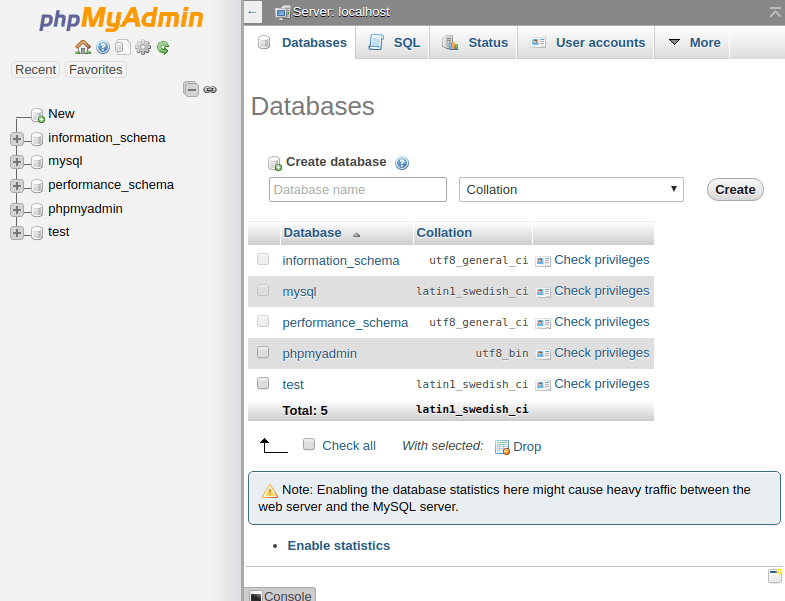

- Launch phpmyadmin ubuntu how to#
- Launch phpmyadmin ubuntu install#
- Launch phpmyadmin ubuntu update#
- Launch phpmyadmin ubuntu manual#
- Launch phpmyadmin ubuntu full#


Once you have logged in you should be able to manage all the MySQL databases from your browser. To launch phpMyAdmin, visit the URL: and log in with your MySQL root username and password. Log in to phpMyAdmin by using the following credentials: Username: root. How do I open phpMyAdmin in terminal?Īccess the phpMyAdmin console through the secure SSH tunnel you created, by browsing to. Then select Apache 2 for the webserver you wish to configure. If no users have been setup, use admin with no password to login. You should be able to login using any users youve setup in MySQL. Once phpMyAdmin is installed point your browser to to start using it.
Launch phpmyadmin ubuntu install#
It’s our hope that this tutorial was insightful and that you can seamlessly install phpMyAdmin on your system. Once logged in, you will be presented with the phpMyAdmin panel as shown below. * TO flush privileges and exit the shell. Next, accord all privileges to the user as shown > GRANT ALL PRIVILEGES ON *. Thereafter proceed and create a new database user : > CREATE USER IDENTIFIED BY 'your-password If you encounter an error while logging into phpMyAdmin, follow the steps provided:įirst, access the MySQL database as shown: $ sudo mysql -u root -p On your browser, browse the address shown: The phpMyadmin login page comes to view as shown. The last step in the installation is to access the phpMyAdmin interface.
Launch phpmyadmin ubuntu full#
The output should appear as follows providing you with the full path to the configuration file and the symbolic link it points to. To ensure that the installation was successful, run the following command to confirm that the nf configuration file exists. Step 2: Verify successful installation of PhpMyAdmin > show databases īe sure to locate the phpmyadmin database as seen in the snippet provided.Īdditionally, you can view the privileges assigned to the phpmyadmin user on the phpmyadmin database by invoking: > show grants for To display the existing databases execute the MySQL command as follows. If you want to feed your curiosity, proceed and access your database as shown. Once the installation is complete, a new database called phpmyadmin is created with the user phpmyadmin. The installation will then continue with the installation of the required packages, dependencies and PHP extensions that will be required by phpMyAdmin. Thereafter, provide the password for phpMyAdmin. Select the ‘ Yes’ option to tweak the phpMyAdmin database with the dbconfig-common package and hit ENTER. Thankfully, the setup provides you an option to configure the database using the dbconfig-common which simplifies the configuration.
Launch phpmyadmin ubuntu manual#
Manual configuration is hectic and tedious. The phpMyAdmin package requires the installation and configuration of a database before use. Since you already have Apache installed, press the TAB key on the ‘Apache’ option and hit ENTER. $ sudo apt install phpmyadminĪlong the way, you will encounter some prompts. The phpMyAdmin package is available on Ubuntu repositories, therefore, use the APT package manager to install it as follows.
Launch phpmyadmin ubuntu update#
Step 1: Install PhpMyAdminįirstly, access your terminal and update your package lists using the command provided.
Launch phpmyadmin ubuntu how to#
If you don’t have it already, please head over to our article on How to install LAMP.Īdditionally, ensure that you have configured a sudo user on your instance of Ubuntu 20.04. As such, ensure that you have installed LAMP on Ubuntu 20.04. PhpMyAdmin is PHP-driven and runs on the front-end. In this guide, we delve into the installation of phpMyAdmin. It allows users to log in and easily perform database management tasks such as managing databases, users, and permissions to mention a few. Written in PHP, phpMyAdmin is a wonderful free and open-source tool that provides a front-end web interface to MySQL or MariaDB. However, not everyone is a fan of the command-line, and this is where phpMyAdmin is beneficial. With a few commands, you can access the database shell and perform a variety of tasks including viewing and creating databases and database users. The native tool for access MySQL or MariaDB databases is the command-line.


 0 kommentar(er)
0 kommentar(er)
